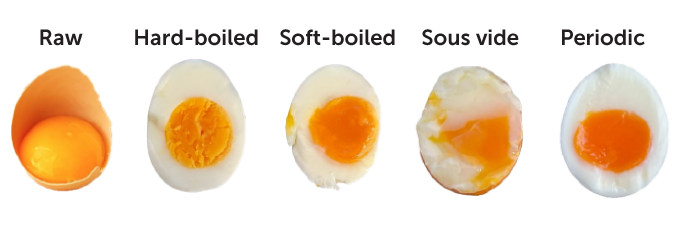When egg prices are cooking with difficulty, it is important to make sure that every egg you do is the best it may be. But when your egg white is cooked, the yellow of your egg is often still a run. Once yellow and white is cooked, the white is rubber. Solution is a method of periodic cooking, researchers report on February 6 Communication Engineering. And, they say, they say, they say, only requires boiling water, slightly warm water, an egg – and 32 minutes of patience.
The challenge of cooking an egg is that yellow yellow and albumen – or white – have different compositions, says Emilia Di Lorenzo, a chemical engineer at the University of Naples Federico II in Italy. The result is that the proteins in each part of the egg denature – or split – at different temperatures. Yellow yellow proteins cook at 65 ° Cights, while those in white cooking at 85 ° C.
The challenge of warming two parts of a single item at different temperatures appealed to Ernesto di Maio, a materials scientist at the University of Naples Federico II. Its lab concentrates on different border conditions – changing temperatures, pressure or other conditions to create two different internal processes in materials such as plastics.
But then, a colleague told him “” You know, there is a chef in Italy who sells his only egg for 80 euros, “he recalled. “This chef separates the egg and yellow yellow, cooked them at two different temperatures – the optimal one[s] – and then unites them again in a decoration with other ingredients. “When his colleague told Di Maio about the expensive dish,” it was really clear to me to try what we know about plastic forms in the egg. “
Di Lorenzo, Di Maio and their colleagues directed mathematical and calculators of heat transfer inside the egg white and yellow yellow and simulated how different periods and temperatures affected interior materials. They found that periodic cooking – changing the temperature back and forth between 100 ° C and 30 ° C – allowed yellow and white yellow to reach different temperatures at different times.
“When you change a boundary state, the heat will turn, so the heat flow will go from positive to negative and vice versa,” says Di Maio. “After a few cycles, you end up with a stationary solution to this problem, which gives a very constant temperature for yellow yellow, and temperature ranging from 30 ° C to 100 ° C for album.”
The researchers then began to cook real eggs. They compared periodically cooked eggs with raw, boiled, boiled and soft varieties. The team examined the results with spectroscopy and stiffness tests, chewing and bumps – and a panel of 8 sensory experts who measured fragrance, smell, moisture and more. The periodic egg had a white that was comparable to that of a soft boiled egg, but a yellowish yellow more similar to a delightful egg.

Here is the last recipe: prepare a pot of boiling water, and a pot of water at 30 ° C. Put the egg in the boiling water for two minutes, then transfer to the room temperature pot for two minutes. Repeat this 8 times, for a total of 32 minutes.
“It is very refreshing to see people who take food this seriously,” says César Vega, a food scientist and senior director of innovation at McCain Foods, Agoikago. “Let me think, what are the implications of the technique in the food world?” But not everyone is so clumsy. While Di Lorenzo found the fascinating study, she was grateful to transfer the taste test. “Eggs are not my favorite thing in the world, but I ate them once,” she says. “I had to do it for science.”
#cook #egg #minutes
Image Source : www.sciencenews.org